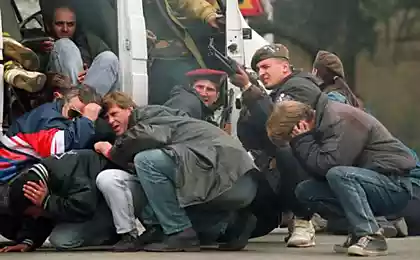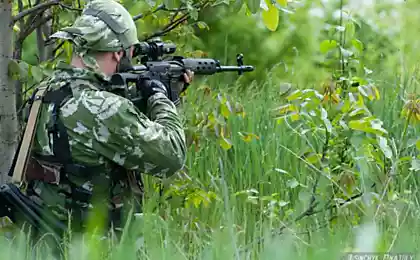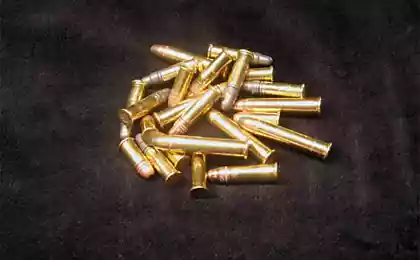941
The weapon did not become a legend
Everyone knows rocket launchers Katyusha, La-5 fighters and Yak-3, Il-2 - the Black Death, the tank legendary T-34 and formidable, invincible IS-2, automatic PCA, which became a symbol of the soldier-liberator in Europe.
But there was another weapon nepoluchitsya worldwide fame, but a very significant contribution to the victory it has made. And some of them, not having received a hundredth of fame famous brands of weapons were in fact the best in the world armaments that great and terrible war.
5 photos.
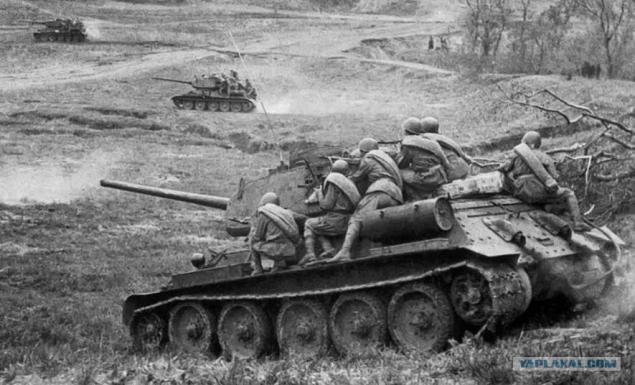
Fighter
Yak-3 is often referred to as one of the best fighters of the Second World War. The incredible speed and maneuverability of the aircraft confidently puts it in this series. But among our best aces you will find not so many flies on the Yak-3. But the aces, as you know, give the best machines. The reason is simple. Outstanding speed data Yak-3 that result in the references include the latest modifications hardly fought. In addition, the relatively weak armament and the fragility of the airframe, led to the fact that the fighter pilots preferred Lavochkin (La-5FN and La-7) and American Airacobras.
However, neither the Yak-3, or La-5, or La-7 did not become the most massive Soviet fighters. And it's not expensive or difficult to manufacture these models, although it played an important role. Lavochkin fighter aircraft have been gaining dominance in the air. They had excellent characteristics that allowed these piston fighters to serve in the Air Force of the Soviet Union until the mid-50s. However, they had one very significant drawback. Motor power made them too greedy, fighters from Lavochkin was a relatively small range.
Needed was a massive, well-armed fighter with greater range to escort bombers. In the second half of the war it was a fighter was in demand the most. That he was the fighter Victory.
Meet - the Yak-9 - the most massive Soviet fighter of the Second World War, issued more than 16 thousand. Airplanes. This real workhorse of the war, was produced from 42 years. The most versatile Soviet fighter of the time, used as a scout, a high-altitude fighter, fighter escort, and even as a fighter-bomber. Despite the relatively low speed, his powerful arms and reliability have made him a good reputation. The Yak-9 aces fly more prominent than the famous Yak-3.

Armoured vehicles
T-34 - certainly the most effective tank of the Second World War. At the beginning of the war he simply had no equal on forces opponents, but in the second half of the war, the combination of speed, armor and firepower, along with the simplicity of the production made it the best tank of its time. During the war, 33,000 were produced T-34 tanks of various modifications.
And who was the second most massive example of the art of our armored forces?
Maybe the famous Tanks heavy tanks - IS? No. SU-100, the magnificent machines that served until the end of the 70s in service with many different countries? Past. Perhaps light tanks such as the T-60, T-70? Again, no.
14 thousand. Armored vehicles from 1942 to 1945 - that's a total release of the SU-76. Self-propelled artillery installation with 76mm instrument (famous ZIS-3).
Track self-propelled unit with a powerful cannon was 42-43gg. the most popular technique after the T-34. Effective gun mounted on top of an open cockpit that allows for a rapid fire at targets, SAU light weight, small size makes it a fast, maneuverable and unobtrusive. Before the advent of the new German tanks (Panther and Tiger) SU-76 has excellent anti-tank weapons, hitting almost any purpose. The gun SU-76 was more powerful and more rapid-than 76mm gun early and medium heavy Soviet tanks (KV and T-34).
Infantry loved the drying, they are always accompanied her, serving as machines assault and assault guns, and direct support in combat. The interaction with the infantry through the open cabin was simple and convenient. But the tankers belonged to the Su-76 in different ways. Unfortunately, almost no weak armor protected her from falling shells, and they were burning well. But the dead tank was still less open cabin allows the crew to quickly leave the ACS.
SU-76, she is drying - very good machine has earned the right to consider himself a weapon of victory.
Photo: Su-76 in Vienna and Berlin
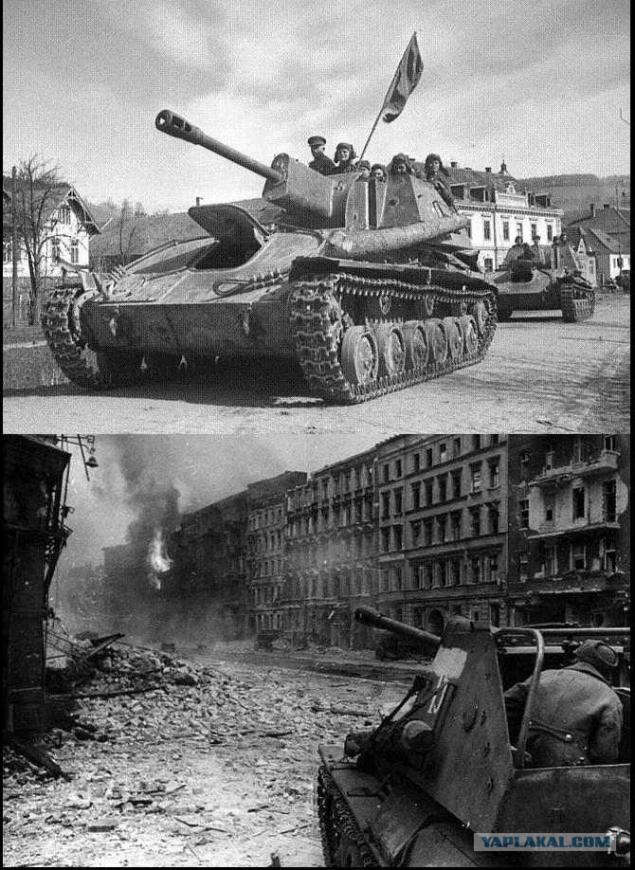
Artillery
Gunners - gods of war. How many books have been written, how many movies filmed about them. But let me ask you, how many of you have read about the mortar? No, not about rocket launchers, mortars and the most common of the Second World War. Every second at the front was not killed or wounded infantry sweeping circuit lead machine-gun fire and exploding shells formidable artillery, destroy any fortifications, and conventional mortar - the same portable infantry artillery, often the most common battalion mortars.
What heroic ask you shoot enemy positions without even seeing him? After firing a mortar mounted on the path, taking out the enemy behind the fortifications, even in the trenches. That is why the position of mortar have always been the number one goal for all weapons. Aviation, artillery, small arms, mortars, the enemy - all in order to destroy the mortar position. The highest loss suffered is mortar battalion calculations, which have always been at the forefront.
Here it is, the weapon of victory, 82-mm mortar BM-37 (index GAU-52 M-832SH) - Soviet battalion 82 mm mortar model 1937 year. Best Mortar Battalion of the Second World War. Easy, unpretentious calculation could be transferred out of 3 people. Range of shooting - 3 km. Clearly superior, both German and mortars of the same class allies. It was in service until the 70s.
Before the war, produced 14 thousand. Pieces, during the war - tens of thousands of barrels.
Photo: detachment of Stalingrad

Assault Rifles
PCA - perhaps the most famous Soviet sub-machine gun. 6 million. These machines were produced during the war. Beautiful and dangerous weapon. But bad luck, abroad it is not called the best submachine gun World War II. What's the problem?
The fact that the sub-machine gun in the classic sense, or considered as an auxiliary weapon (tank crews, artillerymen, the commanders of junior staff, gendarmerie) or as a weapon of subversive groups.
PCA with its huge rate of fire (900 rounds per minute) and great for the submachine gun firing range just does not fit into this framework. He was too cumbersome, although the weight of comparable foreign models. In fact, the PCA was, in fact, not a subsidiary, as the main weapon, occupying niche subsequently occupied by assault rifles and machine guns.
And here is another sub-machine gun is often called the best Western experts submachine gun World War II.
This PPS submachine gun. Established in '42. Lightweight, compact, reliable, cheap and easy to mass produce. Capacious store of 35 rounds, rate of fire 600 rounds per minute, good accuracy, good destructive power cartridge - all this became his strengths. PPS quickly became a favorite weapon tank. This submachine gun was so good and technologically that even in Germany at the end of the war began to produce these weapons. However, as in Finland. After the war, the PPP issue and was in service not only in socialist countries, but also some Western countries - Finland, Spain and Germany until the late 50s.

But there was another weapon nepoluchitsya worldwide fame, but a very significant contribution to the victory it has made. And some of them, not having received a hundredth of fame famous brands of weapons were in fact the best in the world armaments that great and terrible war.
5 photos.

Fighter
Yak-3 is often referred to as one of the best fighters of the Second World War. The incredible speed and maneuverability of the aircraft confidently puts it in this series. But among our best aces you will find not so many flies on the Yak-3. But the aces, as you know, give the best machines. The reason is simple. Outstanding speed data Yak-3 that result in the references include the latest modifications hardly fought. In addition, the relatively weak armament and the fragility of the airframe, led to the fact that the fighter pilots preferred Lavochkin (La-5FN and La-7) and American Airacobras.
However, neither the Yak-3, or La-5, or La-7 did not become the most massive Soviet fighters. And it's not expensive or difficult to manufacture these models, although it played an important role. Lavochkin fighter aircraft have been gaining dominance in the air. They had excellent characteristics that allowed these piston fighters to serve in the Air Force of the Soviet Union until the mid-50s. However, they had one very significant drawback. Motor power made them too greedy, fighters from Lavochkin was a relatively small range.
Needed was a massive, well-armed fighter with greater range to escort bombers. In the second half of the war it was a fighter was in demand the most. That he was the fighter Victory.
Meet - the Yak-9 - the most massive Soviet fighter of the Second World War, issued more than 16 thousand. Airplanes. This real workhorse of the war, was produced from 42 years. The most versatile Soviet fighter of the time, used as a scout, a high-altitude fighter, fighter escort, and even as a fighter-bomber. Despite the relatively low speed, his powerful arms and reliability have made him a good reputation. The Yak-9 aces fly more prominent than the famous Yak-3.

Armoured vehicles
T-34 - certainly the most effective tank of the Second World War. At the beginning of the war he simply had no equal on forces opponents, but in the second half of the war, the combination of speed, armor and firepower, along with the simplicity of the production made it the best tank of its time. During the war, 33,000 were produced T-34 tanks of various modifications.
And who was the second most massive example of the art of our armored forces?
Maybe the famous Tanks heavy tanks - IS? No. SU-100, the magnificent machines that served until the end of the 70s in service with many different countries? Past. Perhaps light tanks such as the T-60, T-70? Again, no.
14 thousand. Armored vehicles from 1942 to 1945 - that's a total release of the SU-76. Self-propelled artillery installation with 76mm instrument (famous ZIS-3).
Track self-propelled unit with a powerful cannon was 42-43gg. the most popular technique after the T-34. Effective gun mounted on top of an open cockpit that allows for a rapid fire at targets, SAU light weight, small size makes it a fast, maneuverable and unobtrusive. Before the advent of the new German tanks (Panther and Tiger) SU-76 has excellent anti-tank weapons, hitting almost any purpose. The gun SU-76 was more powerful and more rapid-than 76mm gun early and medium heavy Soviet tanks (KV and T-34).
Infantry loved the drying, they are always accompanied her, serving as machines assault and assault guns, and direct support in combat. The interaction with the infantry through the open cabin was simple and convenient. But the tankers belonged to the Su-76 in different ways. Unfortunately, almost no weak armor protected her from falling shells, and they were burning well. But the dead tank was still less open cabin allows the crew to quickly leave the ACS.
SU-76, she is drying - very good machine has earned the right to consider himself a weapon of victory.
Photo: Su-76 in Vienna and Berlin

Artillery
Gunners - gods of war. How many books have been written, how many movies filmed about them. But let me ask you, how many of you have read about the mortar? No, not about rocket launchers, mortars and the most common of the Second World War. Every second at the front was not killed or wounded infantry sweeping circuit lead machine-gun fire and exploding shells formidable artillery, destroy any fortifications, and conventional mortar - the same portable infantry artillery, often the most common battalion mortars.
What heroic ask you shoot enemy positions without even seeing him? After firing a mortar mounted on the path, taking out the enemy behind the fortifications, even in the trenches. That is why the position of mortar have always been the number one goal for all weapons. Aviation, artillery, small arms, mortars, the enemy - all in order to destroy the mortar position. The highest loss suffered is mortar battalion calculations, which have always been at the forefront.
Here it is, the weapon of victory, 82-mm mortar BM-37 (index GAU-52 M-832SH) - Soviet battalion 82 mm mortar model 1937 year. Best Mortar Battalion of the Second World War. Easy, unpretentious calculation could be transferred out of 3 people. Range of shooting - 3 km. Clearly superior, both German and mortars of the same class allies. It was in service until the 70s.
Before the war, produced 14 thousand. Pieces, during the war - tens of thousands of barrels.
Photo: detachment of Stalingrad

Assault Rifles
PCA - perhaps the most famous Soviet sub-machine gun. 6 million. These machines were produced during the war. Beautiful and dangerous weapon. But bad luck, abroad it is not called the best submachine gun World War II. What's the problem?
The fact that the sub-machine gun in the classic sense, or considered as an auxiliary weapon (tank crews, artillerymen, the commanders of junior staff, gendarmerie) or as a weapon of subversive groups.
PCA with its huge rate of fire (900 rounds per minute) and great for the submachine gun firing range just does not fit into this framework. He was too cumbersome, although the weight of comparable foreign models. In fact, the PCA was, in fact, not a subsidiary, as the main weapon, occupying niche subsequently occupied by assault rifles and machine guns.
And here is another sub-machine gun is often called the best Western experts submachine gun World War II.
This PPS submachine gun. Established in '42. Lightweight, compact, reliable, cheap and easy to mass produce. Capacious store of 35 rounds, rate of fire 600 rounds per minute, good accuracy, good destructive power cartridge - all this became his strengths. PPS quickly became a favorite weapon tank. This submachine gun was so good and technologically that even in Germany at the end of the war began to produce these weapons. However, as in Finland. After the war, the PPP issue and was in service not only in socialist countries, but also some Western countries - Finland, Spain and Germany until the late 50s.









